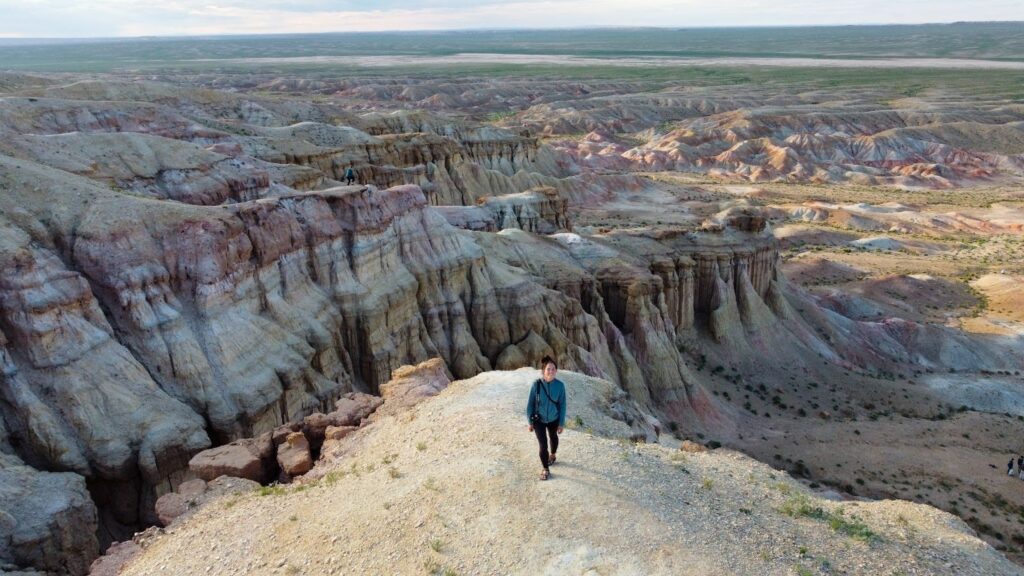By someone who’s sunburned, dust-caked, and absolutely enamored with the Gobi.
There are places you visit because you’re supposed to. Then there are places you stumble into, half-skeptical, slightly lost, and wholly unprepared for the way they’ll brand themselves into your memory. The White Stupa, or Tsagaan Suvarga, is the latter. No tourist infrastructure, no ticket lines. Just wind, color, ancient seabeds, and silence.
If you’re chasing cinematic solitude in Mongolia, this is your sign to keep reading.
What Exactly Is the White Stupa, aka Tsagaan Suvarga?
Located in Dundgovi Province, about 420 kilometers south of Ulaanbaatar, the White Stupa is a dramatic cliff formation carved by ancient seas and relentless wind over 60 million years. Standing about 60 meters high and stretching 400 meters wide, these jagged cliffs resemble the ruins of a crumbling ancient city or a series of layered Buddhist stupas, hence the name.
But don’t let the name fool you. It’s not actually white. At least, not only white. It shifts from chalky beige to terracotta orange to lavender blue depending on the time of day. It’s geological poetry. Think Bryce Canyon meets the Mongolian steppe.
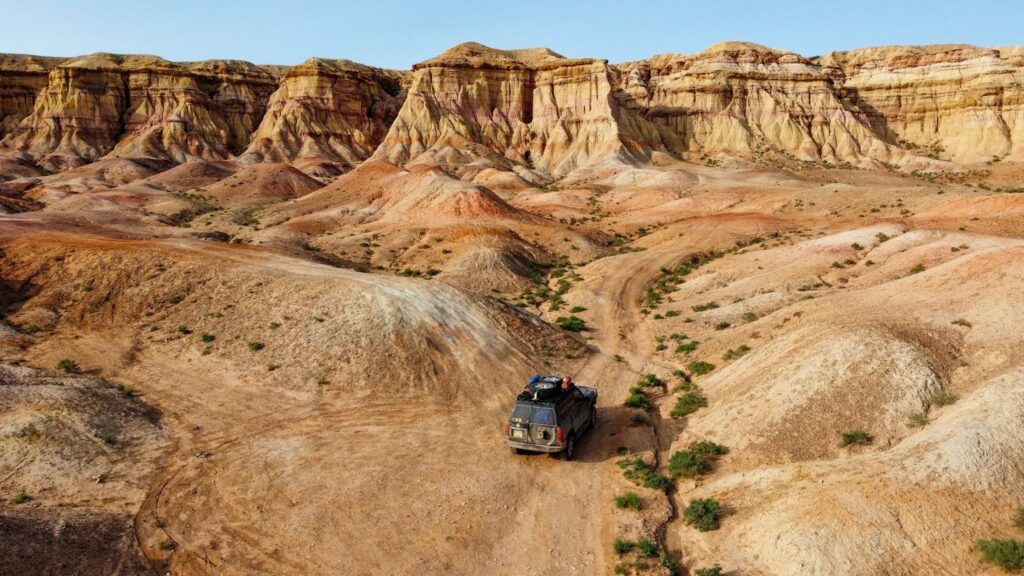
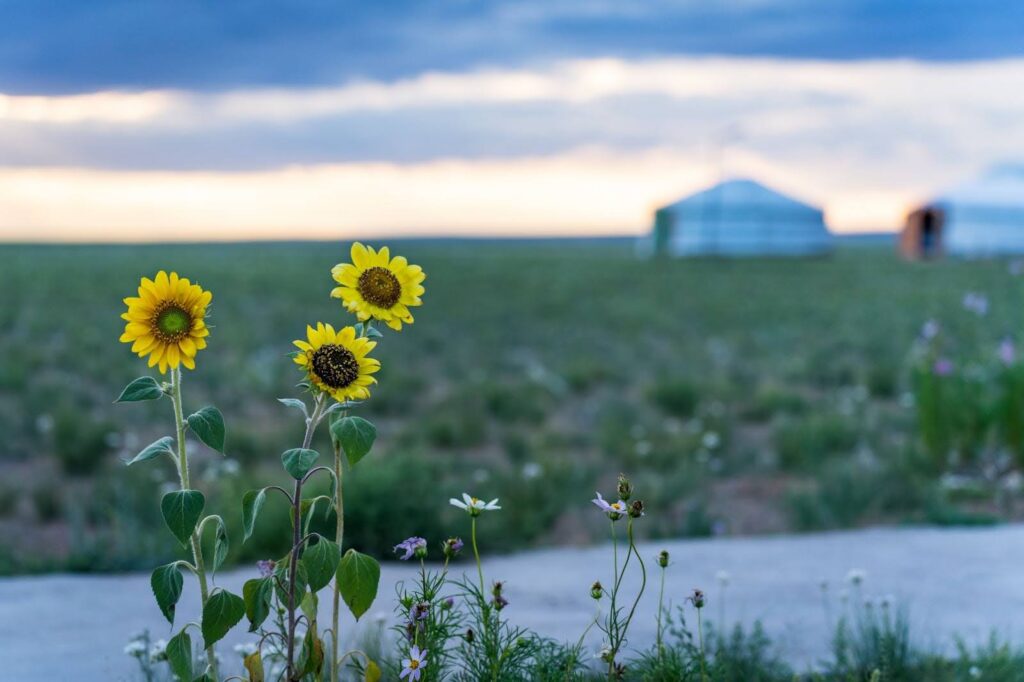
Why Visit White Stupa? What’s the Draw?
The White Stupa is surely one of the most impressive attractions in Mongolia. It’s a striking canyon wall of beautiful colors (despite the name). It’s a must-see for everyone who travels to the country in search of stunning landscapes. Travelers who value raw beauty, quiet places, and the visceral thrill of being somewhere that feels utterly other will especially enjoy this sight. Here are a few of the many reasons to pay White Stupa a visit.
- Experience the Gobi’s surreal, multicolored geology up close.
- Camp beneath a blanket of stars with no light pollution for miles.
- Hike among rock formations that feel more like sculptures than cliffs.
- Encounter ancient petroglyphs and sacred ovoo mounds still used in shamanistic rituals.
If you’re a geology nerd, photographer, or soul-searching wanderer, this place is a hidden gem.
Reaching White Stupa
There’s no direct public transport to the White Stupa, so getting there is half the adventure. In fact, White Stupa, while seemingly close to the main Ring Road, is one of the slightly further-flung attractions in Mongolia.
Best Option: Drive yourself
From Ulaanbaatar: The drive takes 7–9 hours on average. Fortunately, it’s super easy to pair with other iconic Mongolia destinations like the Flaming Cliffs and Khongoryn Els.
The drive to the White Stupa from Ulaanbaatar is mostly smooth, with about 90% of the route (300 km or so) being paved. This means, with a car rental from AVIS, it’s easy to reach! The final stretch transitions to hard-packed dirt, easy to follow but deeply rutted, making for a slow, bumpy, and noisy ride.
While the route is generally straightforward, the paths beneath the White Stupa, where you should drive for the most dramatic views, can be steep and crumbly. Caution and a high-clearance 4WD is recommended.
Pro-Tip: GPS isn’t always reliable. Download offline maps (Maps.me) and bring a physical map as backup. Route guidance is included on all Explorer.Company self drive tours including the tour to Gobi passing the White Stupa.
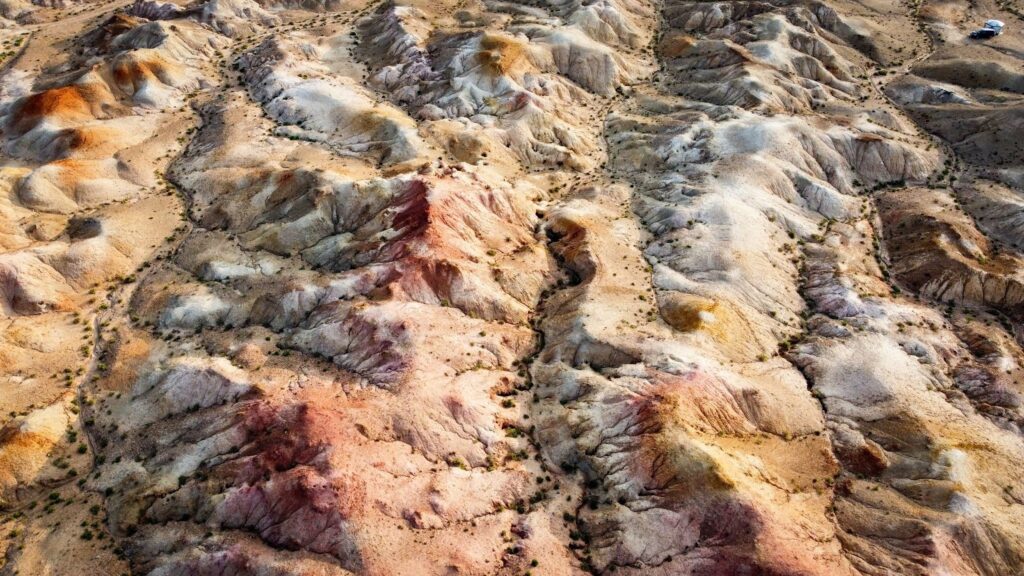
Join a tour (like a Self-Drive Tour)!
The most popular way to visit Mongolia is with a tour. This allows you to focus on the fun and leave the route planning to someone else.
Self-drive tours are relatively new to the Mongolia travel scene. This allows you to drive yourself through all the iconic and spectacular sights, including the White Stupa, while navigating along an easy-to-follow pre-programmed GPS map. It gives you all the flexibility and freedom of a self-drive without the effort!
This is our favorite self-drive tour that includes the White Stupa!
When to Go To White Stupa
Time of year and time of day. Both are equally important if you’re hoping to see the colors of the White Stupa in all their brilliance.
Best Time of Year to Visit
Peak season in Mongolia is Late May through Early September. This is because popular destinations like the Gobi experience dramatic swings in temperature outside of these months. Especially if you are planning on camping or driving yourself, you’ll want to visit during the months that temperatures are conducive to outdoor activities.
If you plan to visit on either end of this range, be sure you’re prepared for cold nights.
Best Time of Day for Photography
Visit at the wrong time of day, and the orange and pink hues of the walls of White Stupa will be muted and unimpressive. Direct sunlight definitely doesn’t help the impressive palate. In fact, cloudy days are some of the most beautiful on the vast Mongolian Steppe.
Specifically, you should visit the top of White Stupa for sunset (and the golden hour before) and watch the sinking sun cast the desert below you in unique colors as the sky paints itself pink. Early morning, you’ll want to watch the sunrise from the bottom of the Stupa to get a little different perspective.
Where to Stay Near White Stupa
This isn’t the Ritz. You’re in the Gobi, after all. There aren’t a whole ton of choices when it comes to places to stay. Fortunately, they are both quite beautiful.
1. Stay in a Ger Camp
There are a handful of local ger camps (or traditional yurts) scattered around this region. You’ll be able to see them standing out with their stark white tents in the grassy expanse. Some of them are situated quite close to the best views of the White Stupa, offering surreal views. These will be basic but cozy, and cost around $20-40 per person. You’ll want to have ample cash.
Meals can be arranged, but expect meat-heavy, home-cooked dishes like tsuivan or khuushuur.
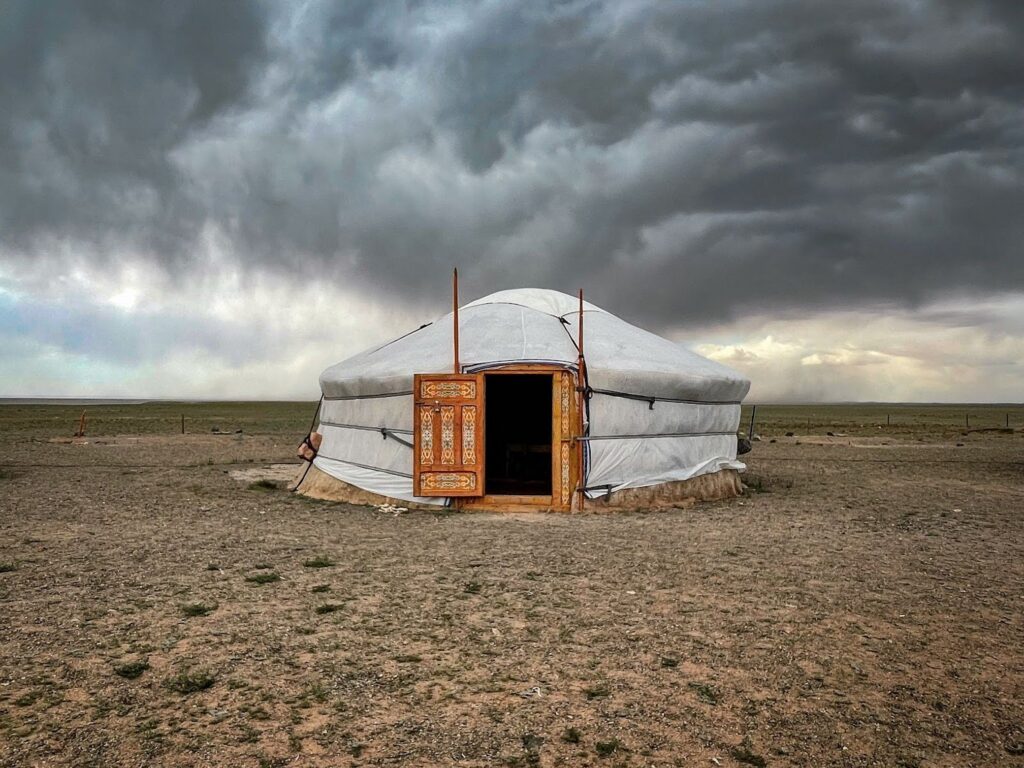
2. Wild Camp at the Base
Camping under a sky so packed with stars it feels almost claustrophobic? Worth every granule of dust in your sleeping bag.
This is ideal if you want that perfect sunrise-over-the-canyon shot or total silence. You can camp at the foot of White Stupa in its towering shadow.
If you’ve chosen to book an AVIS 4×4 rental with camping gear, you’re in luck, this is one of the best wild camping sites in the country. You’ll need to bring your own water, food, and supplies. In fact, you’ll need to be totally self-sufficient as it’s unlikely you’ll have cell service and there are no facilities at the base of the White Stupa.
What to Do While You’re There
You’re not going to spend a week here, obviously, but for a day or two, this place is rich in experience.
1. Hike the Cliffs
Walk along the top of the ridge for stunning panoramic views of the surrounding desert landscape. The colors shift throughout the day, making sunrise and sunset especially breathtaking. Carefully descend into the valley below; the terrain is crumbly, so sturdy shoes are a must. Along the way, watch out for dramatic rock overhangs and hoodoos that catch the light like natural theater sets.
2. Visit a Sacred Ovoo
You’ll see these all over Mongolia, including here near the White Stupa.
These shamanic stone cairns are spiritual landmarks where locals leave offerings to the spirits of the land. Tradition says to walk around the ovoo clockwise three times, toss a rock onto the pile, and make a wish. It’s important to respect the sacred nature of these sites, never climb on or disturb them, as doing so is considered deeply offensive.
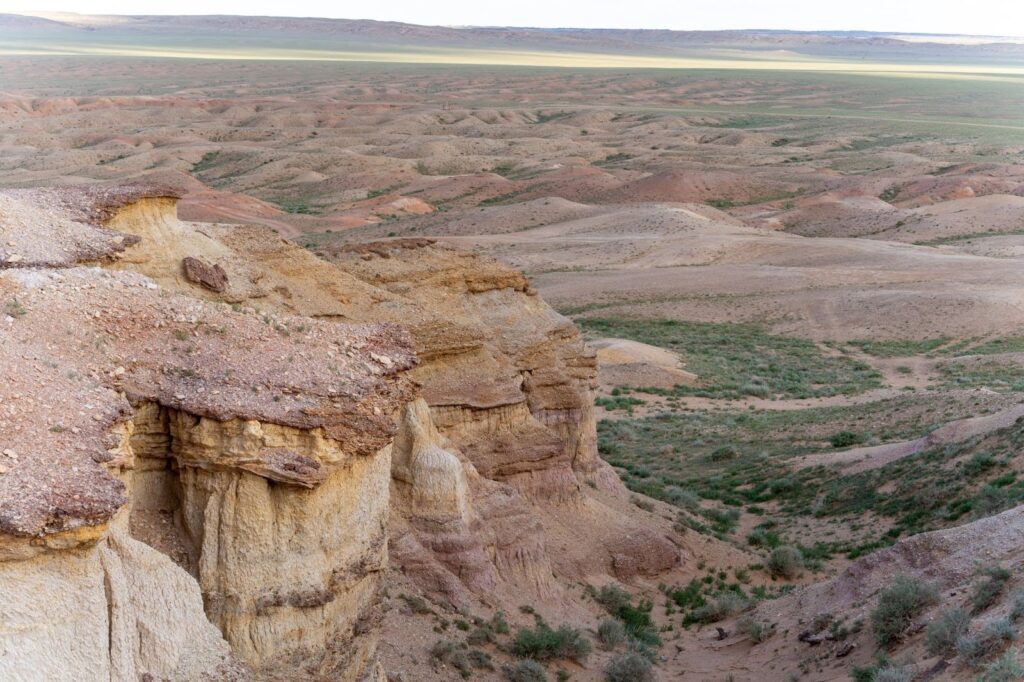
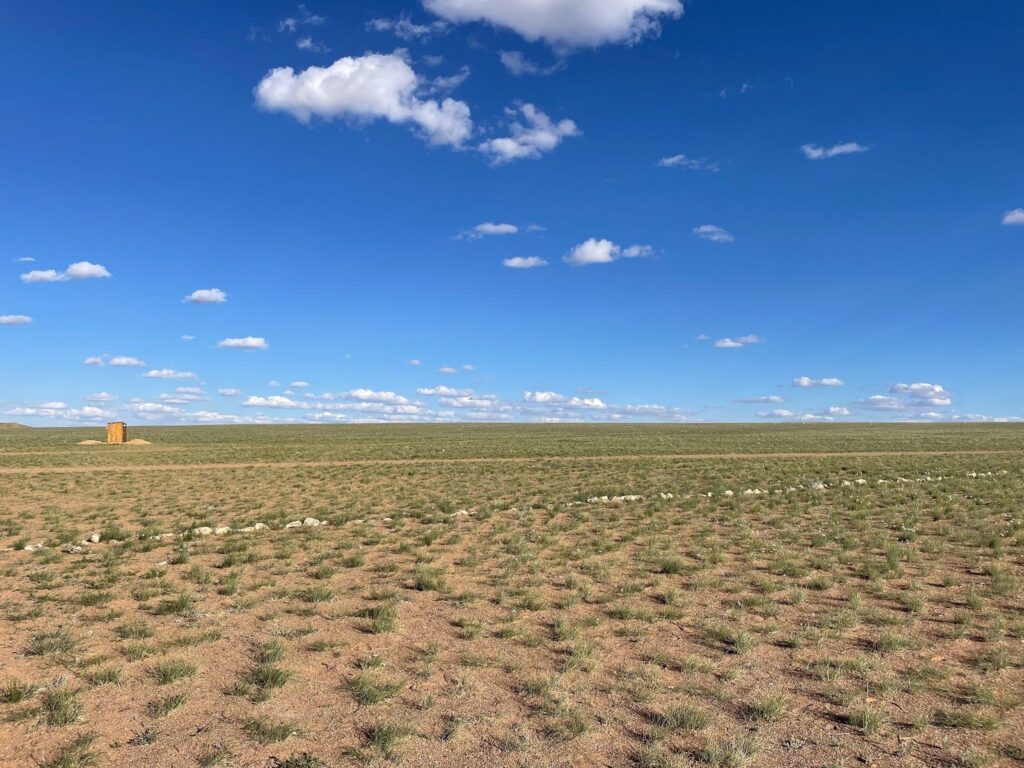
3. Search for Petroglyphs
Just a few kilometers from the cliffs lies Del Uul, home to ancient rock carvings that date back 3,000 to 5,000 years. Etched into the stone are depictions of hunters, camels, and early Mongolian script, offering a glimpse into the distant past. The site can be hard to find without a local guide, but the search itself adds to the sense of adventure.
4. Explore Nearby Caves
About 7 kilometers away is Khevtee Bosoo Agui, also known as “The Lie-and-Stand Cave.” This cave is a mix of tight crawls and tall, echoing chambers, making it both a physical challenge and a geological wonder. Wear clothes you don’t mind ripping as you’ll likely be crawling through narrow passages before emerging into cathedral-like spaces.
Practical Tips from Our Mongolia Travel Experts
Here’s the need-to-know info that will help make your trip to the White Stupa a breeze.
- Entrance fee: None
- Bathrooms: Limited (aka, bring tissue and be prepared to squat)
- Water: Bring more than you think you need
- Cell service: Almost nonexistent
- Power: Charge all devices ahead of time; ger camps may have solar power, but no promises.
- Drones: Allowed, and absolutely incredible for capturing the full scale of the cliffs
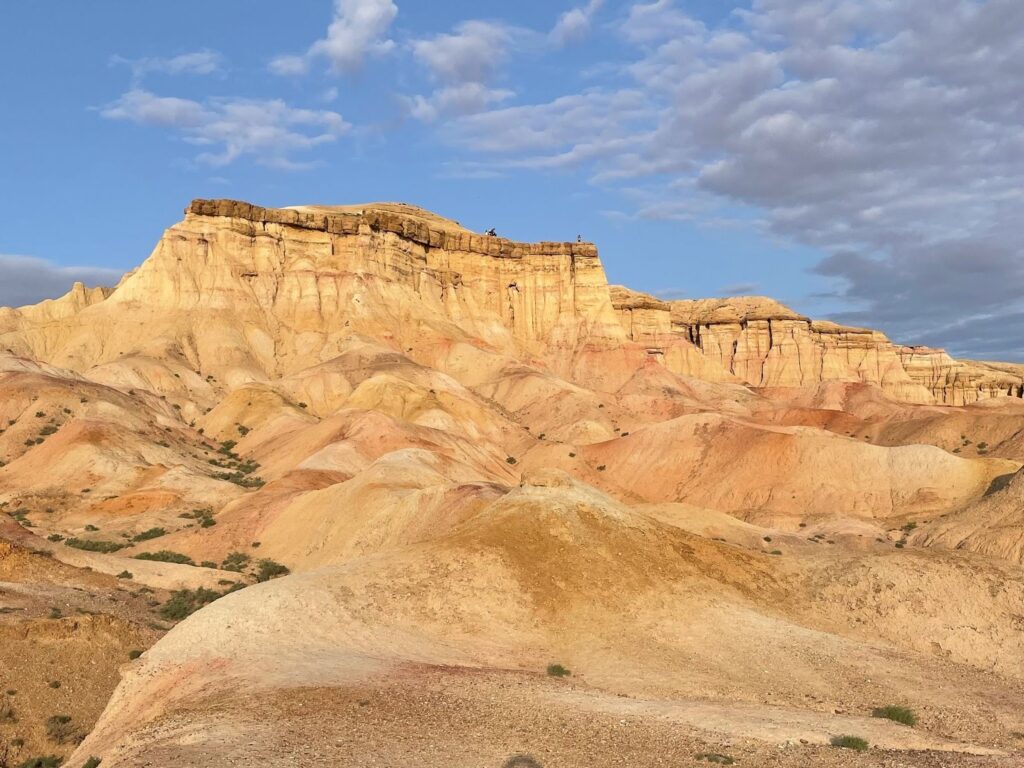
Responsible Travel Matters
You’re a guest in a place still sacred to many. That means following rules nd cultural customs carefully.
- Leave no trash. Pack out what you bring in.
- Don’t fly drones near ovoos or people without permission.
- Try not to carve your own roads and follow the already established tracks to protect the native flora.
These are a few easy rules to follow at all times in Mongolia, but especially important here in this fragile ecosystem.
Come Explore the White Stupa in Mongolia’s Vast Desert!
The White Stupa is more than a backdrop; it’s a place that shifts you just a little, if you let it. There’s no tour guide narrating its history in your ear. No gift shop waiting at the exit. Just rock, wind, and time.
And in the words of every wide-eyed traveler who’s stood at the edge of Tsagaan Suvarga as the sun sets: This was worth it.

